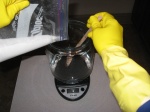How is Soap Made? One Word: Saponification.
"How is soap made?" and "What is saponification" is usually the very first questions that new soap makers ask. After all, these are logical first question when your goal is to create soap at home.
What is SAPONIFICATION?
Any guesses?
Well you asked for it.
Saponification is a chemical process that produces soap from fatty acid derivatives. Traditionally, saponification involves hydrolysis of esters under basic conditions to form an alcohol and the salt of a carboxylic acid (carboxylates). Saponifiable substances are those that can be converted into soap.
To make soap we need the following materials:
Cosmetic clays
Essential oils
Natural Exfoliators
Natural Colorants
Soap cutters
Soap making herbs
Soap making oils
Wooden log molds
lye
Now that you have all your ingredients and equipment prepared, you are ready to begin the actual lye soap making procedure.
At this point, make sure that you are wearing your rubber gloves and goggles. Don't take them off until you are completely done with all the cold process soap making steps!
Step 1: First, you need to prepare the lye solution by mixing the carefully weighed dry lye according to the recipe with the appropriate amount of water.
Make sure that you never use hard water for cold process soap making because the unwanted substances within the water could take part in the reaction. You can get your water tested for hardness at your local appliance store.
Tip: If you have hard water, and don't want to undergo the expense of purchasing a water softener, I urge you to buy distilled water. I personally always use distilled water in my soap recipes... I think it's just good practice.


How much water do you use? Well, most soap recipes will tell you, but as a general rule, use an approximate 1/3 lye to water ration - 3 ounces of water for every 1 ounce of lye.